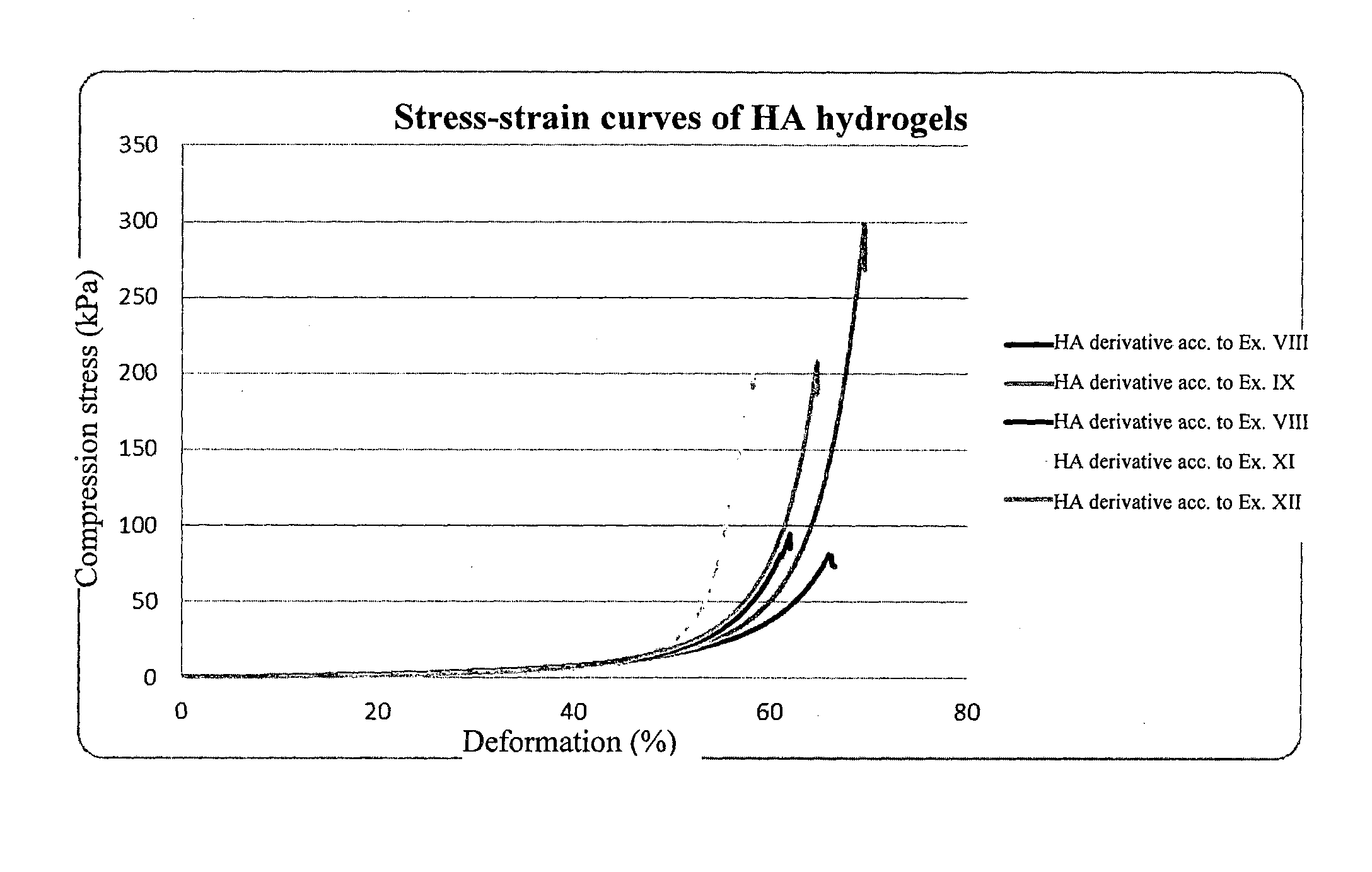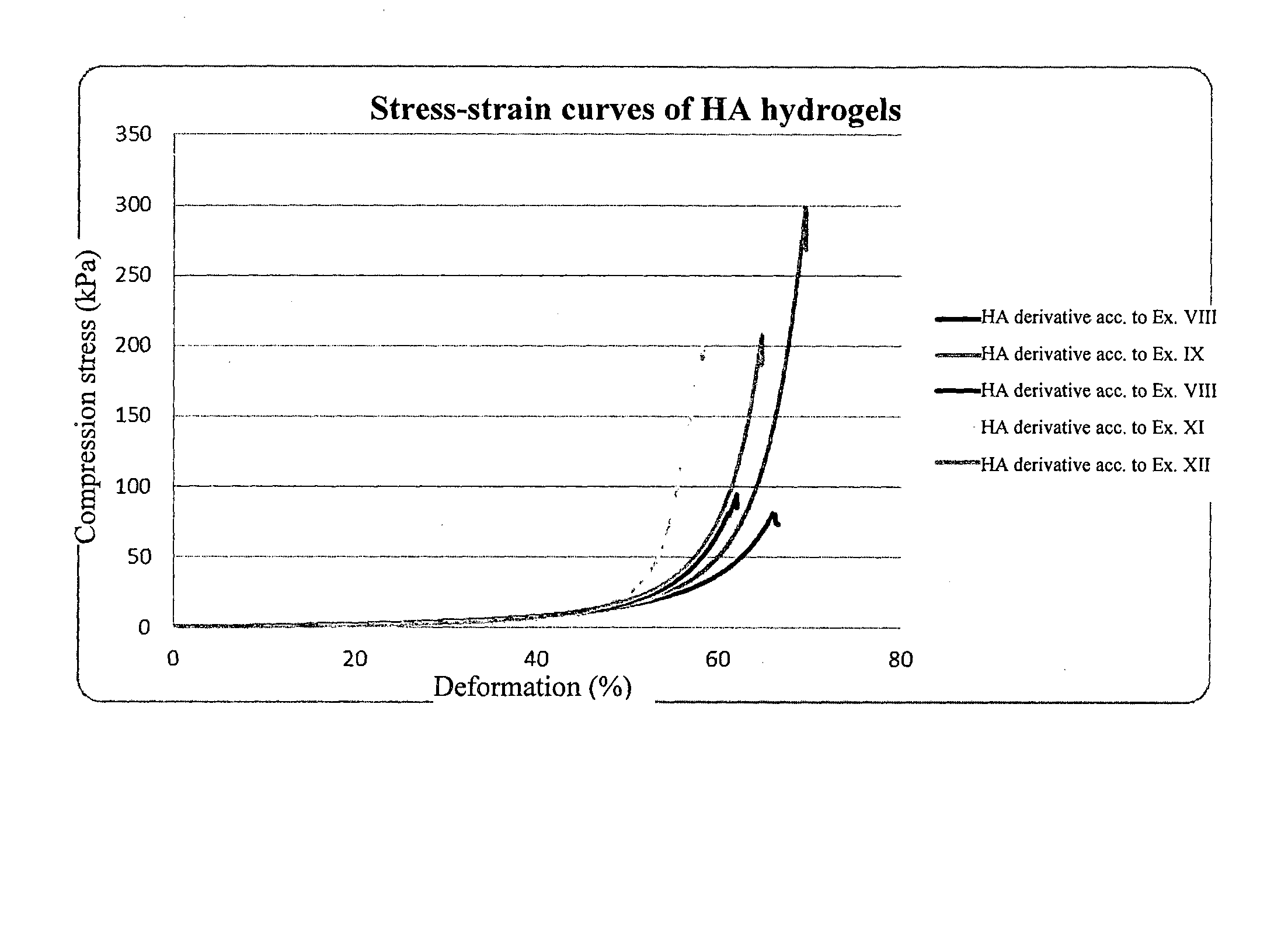Derivatives of hyaluronic acid capable of forming hydrogels
a technology of hyaluronic acid and hydrogel, which is applied in the field of new hyaluronic acid derivatives, can solve the problems of significantly restricting the use of hydrogels and increasing fragility, and achieves the effects of increasing crosslinking concentration, increasing strength of hydrogels based on hyaluronic acid, and increasing crosslinking concentration
- Summary
- Abstract
- Description
- Claims
- Application Information
AI Technical Summary
Benefits of technology
Problems solved by technology
Method used
Image
Examples
example 1.1
Synthesis of 6-amino-N-[2-(4-hydroxyphenyl)ethyl]hexanamide (intermediate spacer-ligand (I))
[0047]6-[(tert-butoxycarbonyl)amino]hexane acid (1.00 g, 4.3 mmol) was dissolved in 50 ml of tetrahydrofuran (THF). To this solution of acid 1,1′-carbodiimidazol (0.70 g, 4.3 mmol) was added. The mixture was heated to 50° C. for sixty minutes. Then the reaction vessel was washed with an inert gas. To the reaction mixture tyramine (0.59 g, 4.3 mmol) was added. The mixture was further heated for another 2 hours. Then THF was removed by means of reduced pressure distillation. The evaporation residue was dissolved in 50 ml of ethylacetate. The solution was washed with 150 ml of purified water (divided into three parts). The organic layer was dried above a molecular sieve. Ethylacetate was removed by means of reduced pressure distillation. The evaporation residue was dissolved in 50 ml of MeOH and 2 ml of trifluoroacetic acid (TFA) were added. The solution was heated for 6 hours under reflux. The ...
example 1.2
Synthesis of 4-amino-N-[2-(4-hydroxyphenyl)ethyl]butanamide (intermediate spacer-ligand (II))
[0051]4-[(tert-butoxycarbonyl)amino]butane acid (0.50 g, 2.5 mmol) was dissolved in 25 ml of tetrahydrofuran (THF). To the solution of acid 1,1′-carbodiimidazole (0.40 g, 25 mmol) was added. The mixture was heated to 50° C. for sixty minutes. Then the reaction vessel was washed with an inert gas. To the reaction mixture tyramine (0.34 g, 25 mmol) was added. The mixture was further heated for another 2 hours. Then THF was removed by reduced pressure distillation. The evaporation residue was dissolved in 50 ml of ethylacetate. The solution was washed with 150 ml of purified water (divided into three parts). The organic layer was dried above a molecular sieve. Ethylacetate was removed by means of reduced pressure distillation. The evaporation residue was dissolved in 50 ml of MeOH and 2 ml of trifluoroacetic acid were added. The solution was heated for 6 hours under reflux. The solvent was remo...
example 1.3
Synthesis of 8-amino-N-[2-(4-hydroxyphenyl)ethyl]octanamide (intermediate spacer-ligand (III))
[0055]8-[(tert-butoxycarbonyl)amino]octane acid (0.50 g, 1.9 mmol) was dissolved in 25 ml of tetrahydrofuran (THF). To the solution of acid 1,1′-carbodiimidazole (0.31 g, 1.9 mmol) was added. The mixture was heated to 50° C. for sixty minutes. Then the reaction vessel was washed with an inert gas. To the reaction mixture tyramine (0.26 g, 1.9 mmol) was added. The mixture was further heated for another 2 hours. Then THF was removed by reduced pressure distillation. The evaporation residue was dissolved in 50 ml of ethylacetate. The solution was washed with 150 ml of purified water (divided into three parts). The organic layer was dried above a molecular sieve. Ethylacetate was removed by means of reduced pressure distillation. The evaporation residue was dissolved in 50 ml of MeOH and 2 ml of trifluoroacetic acid were added. The solution was heated for 6 hours under reflux. The solvent was r...
PUM
| Property | Measurement | Unit |
|---|---|---|
| temperature | aaaaa | aaaaa |
| temperature | aaaaa | aaaaa |
| molecular weight | aaaaa | aaaaa |
Abstract
Description
Claims
Application Information
 Login to View More
Login to View More - R&D
- Intellectual Property
- Life Sciences
- Materials
- Tech Scout
- Unparalleled Data Quality
- Higher Quality Content
- 60% Fewer Hallucinations
Browse by: Latest US Patents, China's latest patents, Technical Efficacy Thesaurus, Application Domain, Technology Topic, Popular Technical Reports.
© 2025 PatSnap. All rights reserved.Legal|Privacy policy|Modern Slavery Act Transparency Statement|Sitemap|About US| Contact US: help@patsnap.com



